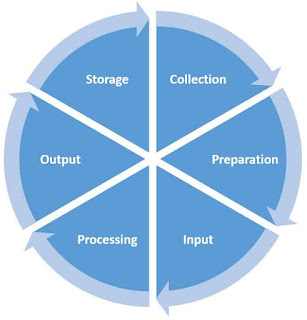Data processing is the process of collecting and transforming
data into useful information through the use of a computer.
The output or “processed” data can be obtained in different
forms like image, graph, table, vector file, audio, charts or any other desired
format depending on the software or method of data processing used.
Stages of the Data Processing Cycle
The Data Processing Cycle is a series of steps
carried out to extract useful information from raw data. Although each step
must be taken in order, the order is cyclic.
The output and storage stage can lead to the repeat of the data
collection stage, resulting in another cycle of data processing. The
cycle provides a view on how the data travels and transforms from collection to
interpretation, and ultimately, used in effective business decisions.
Listed below are the main stages of the data processing cycle:
1) Collection is the first stage of the cycle,
and is very crucial, since the quality of data collected will impact heavily on
the output. The collection process needs to ensure that the data gathered are
both defined and accurate, so that subsequent decisions based on the findings
are valid. This stage provides both the baseline from which to measure, and a target
on what to improve.
2) Preparation is the
manipulation of data into a form suitable for further analysis and processing.
Raw data cannot be processed and must be checked for accuracy. Preparation is
about constructing a data set from one or more data sources to be used for
further exploration and processing. Analyzing data that has not been carefully
screened for problems can produce highly misleading results that are heavily
dependent on the quality of data prepared.
3) Input is the task where
verified data is coded or converted into machine readable form so that it can
be processed through an application. Data entry is done through the use of a
keyboard, scanner, or data entry from an existing source. This time-consuming
process requires speed and accuracy. Most data need to follow a formal and
strict syntax since a great deal of processing power is required to breakdown
the complex data at this stage. Due to the costs, many businesses are resorting
to outsource this stage.
4) Processing is
when the data is subjected to various means and methods of powerful technical
manipulations using Machine Learning and Artificial Intelligence algorithms to
generate an output or interpretation about the data. The process may be made up
of multiple threads of execution that simultaneously execute instructions,
depending on the type of data.
5) Output and interpretation is
the stage where processed information is now transmitted and displayed to the
user. Output is presented to users in various report formats like graphical
reports, audio, video, or document viewers. Output need to be interpreted so
that it can provide meaningful information that will guide future decisions of
the company.
6) Storage is the last stage in
the data processing cycle, where data, and metadata (information about data)
are held for future use. The importance of this cycle is that it allows quick
access and retrieval of the processed information, allowing it to be passed on
to the next stage directly, when needed.
Methods of data processing
- Manual data processing: In this method data is processed manually without the use of a machine, tool or electronic device. Data is processed manually, and all the calculations and logical operations are performed manually on the data.
- Mechanical data processing – Data processing is done by use of a mechanical device or very simple electronic devices like calculator and typewriters. When the need for processing is simple, this method can be adopted.
- Electronic data processing – This is the modern technique to process data. The fastest and best available method with the highest reliability and accuracy. The technology used is latest as this method used computers and employed in most of the agencies. The use of software forms the part of this type of data processing. The data is processed through a computer; Data and set of instructions are given to the computer as input, and the computer automatically processes the data according to the given set of instructions. The computer is also known as electronic data processing machine.
Importance
of computer as a tool for data processing
1. Accuracy.
Once data have been correctly entered into the computer component of a data
processing system, the need for further manipulation by humans is eliminated,
and the possibility of error is reduced. Computers, when properly programmed,
aren't able to make computational errors. Of course, computer systems remain
vulnerable to the entry by humans of invalid data.
2. Ease
of communications. Data, once entered, can be transmitted wherever needed
by communications networks. These may be either earth or satellite-based
systems. A travel reservations system is an example of a data communications
network. Reservation clerks throughout the world may make an enquiry about
transportation or lodgings and receive an almost instant response. Another
example is an office communications system that provides executives with access
to a corporate data base, from their personal microcomputer work stations.
3. Capacity
of storage. Computers are able to store vast amounts of information, to
organize it, and to retrieve it in ways that are far beyond the capabilities of
humans. The amount of data that can be stored on devices such as magnetic discs
is constantly increasing. All the while, the cost per character of data stored
is decreasing.
4. Speed.
The speed, at which computer data processing systems can respond, adds to their
value. For example, the travel reservations system mentioned above is not
useful if clients have to wait more than a few seconds for a response. The
response required might be a fraction of a second.
Thus, an
important objective in the design of computer data processing systems is to
allow computers to do what they do best and to free humans from routine,
error-prone tasks. The most cost-effective computer data processing system is
the one that does the job effectively and at the least cost. By using computers
in a cost-effective manner, we will be better able to respond to the challenges
and opportunities of our post-industrial, information-dependent society
Exercises:
1. Define data processing.
2. What is data processing
cycle?
3. Mention and explain
3 stages involved in data processing cycle.
4. Draw data processing
cycle
5. Mention 3 methods
of data processing
6. State 3 importance
of computer as a tool for data processing.


















In any case, because of a plenty of concentrate materials accessible web based, concentrating a course is definitely not a troublesome assignment nowadays. ExcelR Data Science Courses
ReplyDeleteI think I have never seen such blogs ever before that has complete things with all details which I want. So kindly update this ever for us.
ReplyDeleteData Science Course
Well we really like to visit this site, many useful information we can get here.
ReplyDeleteData Science Training
A good blog always comes-up with new and exciting information and while reading I feel that this blog really has all those qualities that qualify a blog to be one.
ReplyDeletedata analytics training in hyderabad
betmatik
ReplyDeletekralbet
betpark
mobil ödeme bahis
tipobet
slot siteleri
kibris bahis siteleri
poker siteleri
bonus veren siteler
045
شركة تنظيف فلل بجازان XU107o2PiT
ReplyDeleteتسليك مجاري mAjr9GKpOu
ReplyDelete